takes on
TE MANA
WHENUA



Friday, 9 December 2022 Whanganui Racecourse
Full agenda and details will be included in the AGM Information Booklet, which will be sent in November.

SHAREHOLDER FARM TOUR & PRE AGM HUI 2022 Saturday, 19 November 2022

To register, contact the Whanganui office: 06 348 7213 or email: office@atihau.com
Registrations close: Friday, 11 November 2022

mitigating
risks


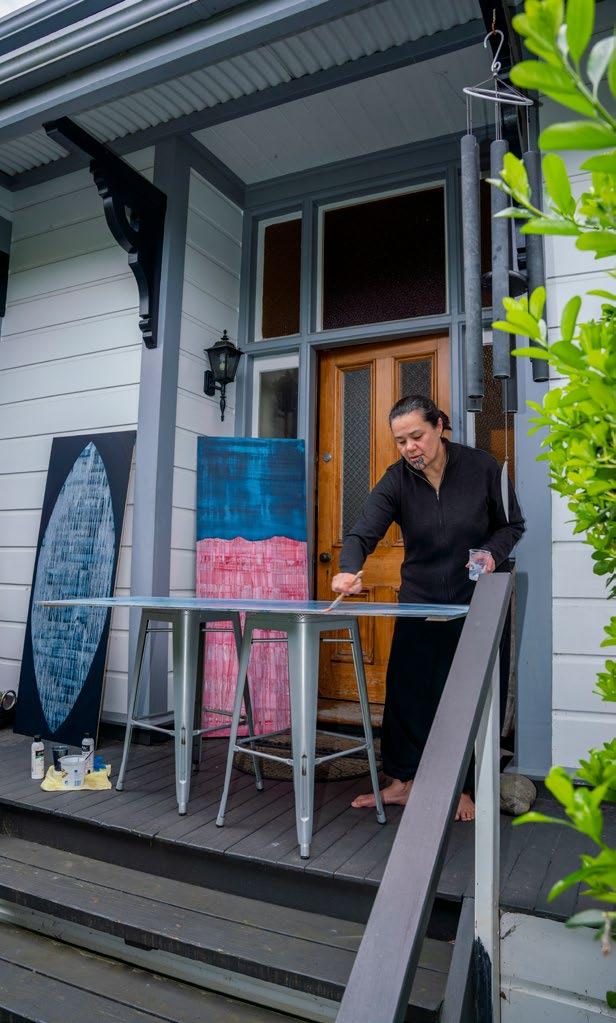
An Awhiwhenua graduate is bringing it home as Te Paenga Station's new Head Shepherd.
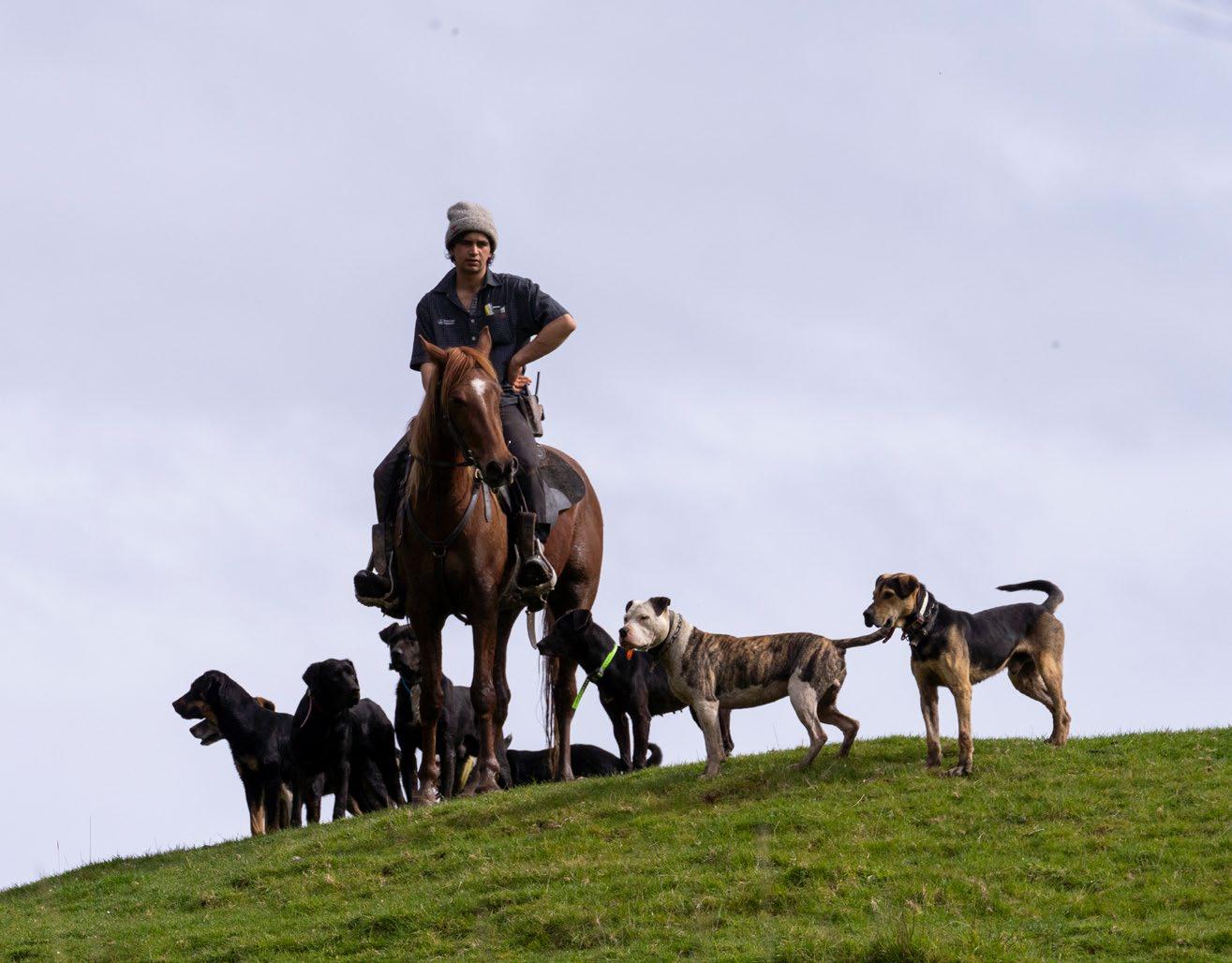
Priorities are clear at the busy Ātihau-Whanganui Incorporation finishing farms.


The joint-venture initiative with Ngā Wairiki Ngāti Apa is progressing well.
RAUKURA NAANI WAITAI IS SUBMERGED IN WATER. Naani Waitai on art and water.
Uri compete in England with the help of Te Āti Hau Trust.
Editor Mavis Mullins
Deputy Editor Moana Ellis
Creative Director Sheree Anaru
Photography Quentin Bedwell
Graphic Design Cherie Quin
INCORPORATION
Postal PO Box 4035
Whanganui 4541
Physical 16 Bell Street Whanganui 4500 Ohakune 22 Ayr Street Ohakune 4625
Telephone +64 (6) 348 7213 Fax +64 (6) 348 7482
Email office@atihau.com www.atihau.com
iSTUDIOS MULTIMEDIA LTD
Postal PO Box 8383
New Plymouth 4340
Physical 77B Devon Street East New Plymouth 4310
Telephone +64 (6) 758 1863
Email info@istudios.co.nz www.istudios.co.nz
Te Paenga Station's new Head Shepherd, Jade Johnson.
Polly Catlin-Maybury
Mark Dawson
Moana Ellis
Virginia Winder
Ko taku tangi mō kautau kua riro atu rā
E haere ki te iwi nui i te pō
Okioki mai rā i te kāinga wairua i te rangi.
Huri te pō, nau mai te ao!
E te mōrehu tangata o te mōrehu whenua
Tēnei rā te mihi kau. Tēnā tātau.
The end of another calendar year enables us to continue to count our blessings, bathe in the memories of those who have passed and look ahead to the new year amongst those who matter.
This will be my very last editorial and I want to acknowledge those who have continued to support me and your elected representatives as we have shared, and had confirmed by you, our strategies and reasons for the direction of travel of our taonga tuku iho, ĀtihauWhanganui Incorporation.
I am proud that in my time we have instigated this AWHI magazine to ensure you have increased access to on-farm information, records of our historic journey, profiles of our kaumātua and celebratory stories of uri achievements.

AWHI magazine continues to report under those elements of Toitū te Whenua, Toitū te Tangata, Toitū te Mana – our land, our people our business. I hope you enjoy this edition and please continue to feed back as to what you read and what more you wish to better understand. I promise you we do listen.

I am humbled and remain honoured that I have been able to add to the legacy that is Ātihau-Whanganui Incorporation.
Ka nui rā te aroha me taku mihi kau,
Mavis Mullins MNZMPeople coming together as one whānau with a shared sense of identity, history and kaupapa makes working for ĀtihauWhanganui Incorporation much more than ‘just a job’.

“It’s special working here because Ātihau is very much a family business,” says Allayne Wallace, a member of the organisation’s Finance team. “Everyone feels part of something bigger than themselves, something that acknowledges and honours the people who walked this path before us and helps us continue to travel that path for the benefit of our tamariki, and their tamariki and so on, for generations to come.
“Everyone you work with is whānau – quite literally in my case, as I work with several cousins here in the office and I have uncles and aunties out there on the farms – and when you do your mahi each day you do your best, because you feel honoured to be part of it.”

Allayne’s experience, and that of other Ātihau-Whanganui Incorporation (Ātihau) kaimahi, has been captured in a set of value statements that each Ātihau team can use as a touchstone for their own approach to the way they work as part of the organisation.
Called The Āti Hau Way, this shared kaupapa will help provide a reference point for all activities, from the smallest decision to the largest.
“The Āti Hau Way is more than just a code of conduct or expectations, it’s a framework that every individual can use to align their mindset and mahi to that of their
colleagues, their team and their wider Ātihau whānau,” says Andrew Beijeman, Ātihau CEO. “This shared culture of our organisation brings us all –kaimahi, shareholders, and board members – closer together, enabling us to really make what we do each day count.
“This sense of kotahitanga not only connects us to each other, but also to those who went before us and left us with the legacy and vision that drives what we do.”
While the culture and tikanga of Ātihau has always been an important element, demonstrated by a number of ‘culture days’ that have been held, the mahi to formalise and encapsulate these behaviours and beliefs has been underway for around a year.
Says Whetu Moataane, Tikanga and Brand Manager for Ātihau: “It was extremely important that the essence of The Āti Hau Way came from our
“This shared culture of our organisation brings us all –kaimahi, shareholders, and board members – closer together, enabling us to really make what we do each day count.”
Andrew BeijemanThe values of The Āti Hau Way are a connecting pathway for kaimahi, shareholders and board members.
people themselves, our kaimahi and shareholders. So we brought them together into a series of workshops to kōrero about what being part of the business meant, what was important to them, and what they felt we need to focus on.

“It was an interesting, and sometimes challenging, process to identify and verbalise what for many is a feeling, or an awareness, and it did take time for people to process what we were trying to achieve.
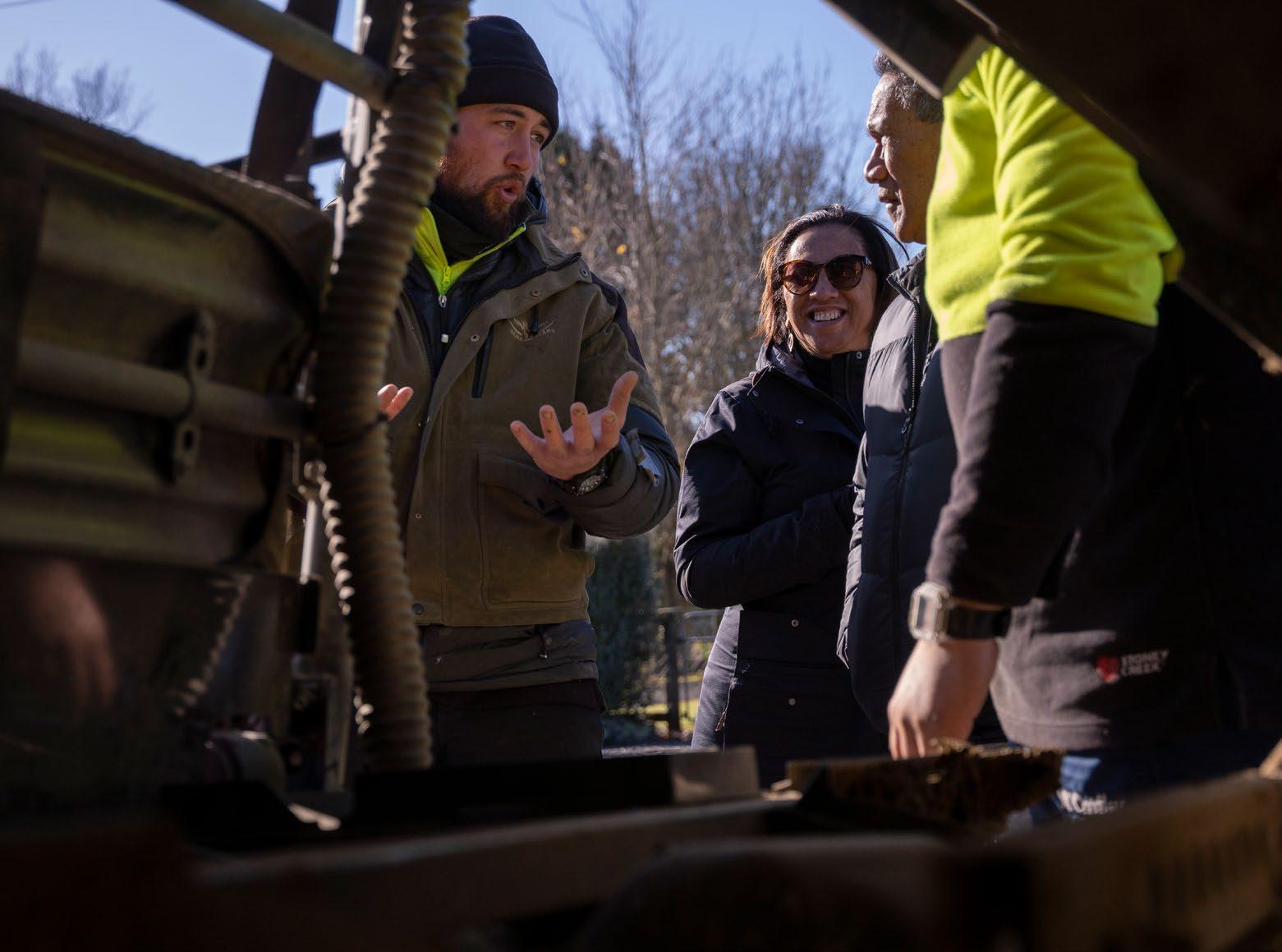
“But as the mutual understanding grew, the kōrero grew, and the participation became very enthusiastic and inclusive. It was quite an amazing experience, actually, watching our people come together over something that is so integral to who we are.”
One of the key elements of the workshops was the opportunity to retell the stories of the first Committee of Management, the vision they had and the
determination they showed to reconnect the people and their whenua despite the obstacles in their way.
“While I think everyone there knew our history, having the time and space to really reflect on the messages and meaning that have come down through the years was really valuable,” says Whetu. “Bringing all that rich cultural tikanga into something that will help support our kaimahi and guide their

waka each day makes The Āti Hau Way a powerful tool for us.”
Some of the workshops were run by Lindy Nelson, who helped create the right environment for people to share in a way that they felt was safe and worthwhile.

“I really want to acknowledge Lindy for the way she approached the workshops and created a really open atmosphere that all participants felt part of, but also for having the courage to ask harder questions and dig beneath the surface to find the real meaning behind what people were saying,” says Andrew. “I’m really proud of where we have got to with The Āti Hau Way. What we have now is very Ātihau specific, has been created with involvement from everyone, and I am excited to see how our teams embrace The Āti Hau Way going forward.
“The next challenge is for each team to interpret what The Āti Hau Way means for them on a day-to-day
basis, to keep reinforcing the value statements, and to measure how we are living up to them through our actions and results.
“I don’t think we will see a huge shift in behaviours because what we have created is already part of what our people are doing,” says Andrew. “We should see these behaviours repeated more regularly, and more evident in how we do our mahi. The Āti Hau Way will help empower our people to make the right decisions at the right time for the right reasons.
“We know one of the reasons people enjoy working for Ātihau is because we are purpose and values led, and The Āti Hau Way should only help with this.”
For Allayne, being asked to take part in the process was a real honour and she was pleased to be able to contribute.
“Because my tūpuna were there at the very beginning, bringing our history and our whakapapa into
“I feel proud that I am part of an organisation that acknowledges and celebrates the mana and integrity of my great koro and his fellow Committee members.”
Allayne Wallace what we do is special and important to me,” she said. “My great koro was Te Huatahi Tanginoa Robert Tapa (Bob) and a picture of him hangs in the boardroom here. There is a thread that runs from him, through my grandmother, his daughter, Christine (Nota) Tapa, her brother Lou Tapa, who was the first Māori farm manager at Ohorea, to me and onto my sons Matiu-Marino and Mōraati Tanginoa.
“I feel proud that I am part of an organisation that acknowledges and celebrates the mana and integrity of my great koro and his fellow Committee members.”

The ongoing coronavirus pandemic, the war in Ukraine and a particularly dry summer have all presented challenges for farming operations.
But chief executive Andrew Beijeman believes ĀtihauWhanganui Incorporation (Ātihau) has stood firm against economic headwinds that have tested global markets.
“Prices have recovered over the past 12 months and have been better than last year,” he said, noting a record high of $9.30 per kilogram of milk solids sustaining the dairy sector.
“On the other hand, January, February, March and April were drier than normal, impacting production.
“Good decision-making early on, such as moving stock, helped and we are getting better at mitigating and managing these challenges.”
The pandemic resulted in staff shortages at processing plants, which impacted the meat sector.
“We had some problems getting stock off farms later in the season, but relative to others were well looked after by our processing partners. Delays at meatworks kept a lid on pricing,” says Andrew.
Disruption to international shipping saw transport costs rise significantly. The vast majority of produce is exported.
“There has been a shortage of shipping capacity and ports have been bogged down, but our partners in the processing industry have dealt with the logistical problems and looked after us.”
Another downside of coronavirus has been the lockdowns in China as that nation attempts to pursue a zero-tolerance strategy.
“China is a big market for honey, but it took very little honey this year.”
Andrew says hive numbers and honey production will be capped over the next few years until demand increases.
The war in Ukraine also presented challenges, particularly the impact of rising inflation and, of course, burgeoning fuel and fertiliser costs.
A worldwide food shortage, however, means that prices across most sectors have been holding up well.
“We have managed to hold or lift production and prices are good, which is helping offset the pressure of rising costs. We managed cash flows really carefully last year and
were able to pay back some debt, which is good.
“Unfortunately, the value of honey in storage decreased and this has impacted the year-end profit. This is an industry-wide issue where having good relationships with honey buyers is really important.”
Faced with a world of uncertainty, a cautious approach has been adopted for the year ahead.
“Most of our product is sold from January through to May, so while pricing is good now, world economies may continue to slow down which could impact pricing. We have capital projects planned but these won’t start until we have more certainty over pricing.
“We have built a robust budget based around conservative numbers. Whatever challenges may be ahead, I am confident we can manage them.”
Andrew Beijeman“Good decision-making early on, such as moving stock, helped and we are getting better at mitigating and managing these challenges.”
Making good decisions early has been a key factor for the Ātihau-Whanganui Incorporation in dealing with fluctuating market forces over the past year.
Annual reporting to Ātihau-Whanganui Incorporation shareholders will include more detailed information on debt, strategy, and performance, presented in ways that are easier to understand.

“
In the upcoming annual reporting, expect to see the first changes, starting with new reporting on individual business units.”
Andrew BeijemanFollowing an independent review, a new reporting framework will enhance the way Ātihau-Whanganui Incorporation (Ātihau) reports performance, communicates with shareholders and tells stories that give meaning to the facts and figures presented.
The four-month review canvassed whānau for their views on how annual reporting to shareholders could focus on presenting more of the information they want and help them make sense of the financials.
Following the consultation process, business advisor KPMG recommended a four-year work programme to introduce an Integrated Reporting framework.
KPMG consulting partner Kaapua Smith (Ngāti Apa, Ngāti Awa, Ngāti Porou) led the review.
“By conducting a current-state review and receiving feedback from shareholders, we have been able to gain a much deeper understanding of what it is shareholders would like to get out of Ātihau’s report.”
She says Integrated Reporting will enhance communication and grow stronger relationships with shareholder whānau and stakeholders.
The review confirmed that current reporting includes the typical components of a standard annual report, focused on the previous
financial year in line with other Māori incorporations and trusts of a similar size and nature.
However, shareholders asked for the financial reports to be made more readable and wanted more detail on debt, core assets, strategy and performance, including business unit comparisons for the farms and apiary.
Ātihau CEO Andrew Beijeman said changes over the next four years would introduce targeted detail – for example, additional performance metrics – and a closer focus on future challenges and opportunities.
“The new reporting will cover some of the same information but will also include more detailed information and storytelling to better understand the historical context and the meaning behind the numbers, including where we’ve come from, our historical context, our strategy, and how we generate value.
“It will detail our performance for the year, our environmental impact, and our impact on our community. There will also be an overview of the year ahead, the key risks and how we will manage them. Finally, there will be a summary of the financials, and this will be presented in a slightly different way to enhance understanding.”
He said it will take four years to introduce all the recommended changes.
“In the upcoming annual reporting, expect to see the first changes, starting with new reporting on individual business units.
“It will also feature enhanced infographics (for example, for key performance indicators), the key achievements and challenges of the year, as well as the customary financial statements including profit, income and expenses.”
Andrew said more work may be needed to drill down into the types of performance measures shareholders would like to see, but Ātihau now had an excellent foundation for designing the new framework in detail.
“It has definitely been a worthwhile experience to know what information we need to be sharing and where we need to do better in our reporting and communications. There was a lot of value in going out and consulting with shareholders and understanding what they want to see.”
Whetu Moataane said the review process had made it clear that more information should be shared throughout the year.
“This might be on our social media platforms, it might be in webinars, or it might mean our directors going out on the road regularly to talk to people kanohi-ki-te-kanohi”
Te Paenga Station has a new Head Shepherd –and Ātihau-Whanganui Incorporation couldn’t be prouder. He is a graduate of the Awhiwhenua farm cadetship – and after several years away, he’s back on home ground with an exciting future ahead of him. Moana Ellis talks to Jade Johnson.


Ten years ago, ĀtihauWhanganui Incorporation (Ātihau) launched an on-farm residential cadetship teaching livestock skills to a small number of cadets each year in a supportive, hands-on setting.
Part of the Ātihau commitment to creating training and work for shareholder whānau, the programme has equipped up to six rangatahi each year with a Level 3 New Zealand National Vocational Certificate in Agriculture and realworld experience that sets them up for farm work on Ātihau whenua or anywhere in Aotearoa.
When Jade Johnson (Te Ātihaunuia-Pāpārangi) was unexpectedly offered a place five years ago on the Awhiwhenua farm cadet programme, he didn’t have to be asked twice.
A cadet had unfortunately had to give up a hard-won place partway through the two-year live-in cadetship, the vacancy providing a young Jade with an opportunity out of the blue.
Just 16 and straight out of Whanganui High School, already hooked on working the land and certain that farming was the life for him, he was itching to broaden his horizons, gain some independence and top up his skill level.

“Since I’ve been a little kid, I’ve always wanted to be a farmer. It’s the lifestyle I grew up with – everything I did was on a farm,” Jade says.
“At 16, I was probably a little bit young to go straight to work – I didn’t even have a driver’s licence. Awhiwhenua gave me a bit more time before going out into the big bad world. I only caught the last part of the course, but it was all good. It got me up to scratch with things like fencing and crops, and the paperwork side of the business.”
There was no cropping on the Whangaehu Valley farm where he cut his teeth – almost literally – on farming. His grandfather, Hubba (Rex) Browning, ran the Smiths’ sheep and beef farm for many years in the valley, and Jade and his family lived just across the road.
Hubba Browning was also farm manager for a stint at Ohorea and before that at Morikau, and young Jade spent as much time as possible on that whenua at weekends and in the holidays, working alongside his Pop.

“I’ve grown up on a farm all my life. Right through since before school I’ve been on a farm, pretty much my whole life since I was a little fulla.
“I never really liked school and have always been better at practical stuff. I tried to go to work as much as I could, although Mum didn’t always agree with that.
“I did anything and everything –just as much as I could help with general farm work, chasing sheep, riding horses. Just being outside with the animals, especially the dogs and horses, working on the land – it’s just what I’ve always wanted to do.”
Gaining stockmanship and general farming experience with his grandfather lay the groundwork for an outstanding cadetship with Awhiwhenua.
"Since I’ve been a little kid, I’ve always wanted to be a farmer. It’s the lifestyle I grew up with – everything I did was on a farm."
A young Jade Johnson spent as much time as possible on the whenua with his koro Hubba (Rex) Browning.
Whetu Moataane says Jade was a stand-out cadet, already at home on the land when he joined the programme.
“The Awhiwhenua farm cadet programme is designed to encourage uri and Māori into sheep and beef farm training. At that time, the theory was provided by Land-Based Training and the practical work was done at Te Pā Station, where Jade lived at Awhiwhenua House with his fellow cadets.
“I’m told he was a very good cadet who showed a lot of promise from the start. Aunty Olive Hawira, who looked after the cadets in Awhiwhenua House at that time, said he was a great kid in the house, and she knew he had a good future ahead of him. He was always one
of the shining stars, both in the theoretical side of training and doing practical mahi on the farm.”
As well as investing in pastures, water, infrastructure and best practice, Ātihau also has a strategic focus on developing people.
Jade is the first graduate of the Awhiwhenua farm cadetship to gain a senior position on an Ātihau farm, and that’s a milestone worth acknowledging and celebrating, says Whetu.
“He’s uri – a shareholder descendant – and he’s a product of the Ātihau vision and a success story for Awhiwhenua. It’s about succession: the aspiration to grow the next Ātihau farm managers. It takes a lot of work and many years to achieve that, but Jade is a fine example of how Awhiwhenua and Ātihau can
support our people toward reaching that goal.”
Jade spent a good part of his cadetship at Papahaua Station, a 2670ha breeding station 24km south of Raetihi on the Matahiwi Track, where there was plenty of opportunity to hone his skills, working up a few dogs, mustering on horseback and making the most of any hunting opportunities in his spare time as well.
After graduating with flying colours, Jade spent several years in the Taihape and Hunterville area. The Awhiwhenua programme encourages graduates to venture out to other farm operations to gain work experience, and then come back to work on Ātihau farms.

Jade started off as a junior shepherd at Taihape, where he built up a few


more dogs for his team – “Finding the right pups, breaking them in and building them up is a part of the job I like” – before taking on a shepherding role in Hunterville.
When a shepherding job came up at Te Paenga Station just over a year ago, Jade jumped at the chance to return home and quickly found his feet.
“This area’s always interested me, it’s got natural character … and I missed the pig-hunting,” Jade says. The link between his grandfather and Ohorea makes him feel at home, and he has family living close by, which further ties him to the area.
In August, at the age of 21, Jade was made Head Shepherd at Te Paenga Station.
He’s taking it in his stride and relishing the new challenge. Te Paenga is a sheep and beef breeding station on 3029 ha of steep to rolling hill country on the Parapara,

half an hour from Raetihi and 40 minutes from Whanganui. It has 10,000 ewes in lamb, 3000 hoggets and 600 mixed-age cows as well as replacement stock, with progeny transferring to Ohotu and Tohunga stations for finishing.
“It’s steep and hard country,” Jade says. “We use horses all the time and do all the mustering by horse.”
He keeps things simple by moving “not too big of a mob” – the biggest mob being moved around is a couple of thousand.
Jade says he feels privileged and lucky to be offered an opportunity to take the next step as Head Shepherd.
“Coming back to work for Ātihau, it’s a privilege. The Awhiwhenua programme promotes the idea that cadets will come back and work for their iwi. That’s what they want to see and it’s kind of cool I’ve been able to do that.”
“I’d like to be a manager one day, but that’s a fair way away yet.”
Ātihau Chief Executive Andrew Beijeman says there is plenty of support at Ātihau to develop good people.
“I’m sure if he commits himself, Jade could go on to become a future farm manager. On farm, he’s the sort of person who’s paying attention to everything that’s going on, and he’s notably proactive in his actions.”
“When he’s ready to do more training, he can pick up Level 4 and 5 training through an ITO (industry training organisation).”
“At the moment, though, he’s focused on gaining experience in his new Head Shepherd role.”
"Coming back to work for Ātihau, it’s a privilege. The Awhiwhenua programme promotes the idea that cadets will come back and work for their iwi. That’s what they want to see and it’s kind of cool I’ve been able to do that."
 Jade Johnson
Jade Johnson
It is easy to find out what takes priority at Ohotu and Tohunga stations – you only have to kōrero for five minutes with stock managers Jordan Barns and Simon Lee.

“Making sure the animals have the best life possible, that they are fit and healthy and cared for, is my main focus for every day,” says Simon Lee. “Every morning we are out there checking on them, feeding out, shifting the breaks, moving the different mobs to new feed, making sure they are all OK.
“Once we know they are all happy, then we start getting on with the other jobs on the list. But the animals always come first.”
Simon is the stock manager for Tohunga Station. He is responsible for the welfare of around 900 ewes and 1200 cattle, with another 11,000 lambs coming onto the farm from other Ātihau breeding stations for finishing during the summer
months. Beef cattle are sent to the works every fortnight, on a week-onweek-off rotation with Ohotu. “December and January get really busy around here, with lambs arriving from other Ātihau stations for finishing before they go off to the works”, he says. “Then we are drenching, sorting them into mobs, making sure they are on good pasture, sorting and drafting almost daily.
“It’s dawn to dusk for sure, but it’s what farming is all about – being out there with the animals and ensuring the farm is productive.”
Jordan, over on Ohotu, follows the same pattern of the seasons and is preparing now for the influx of around 17,500 lambs in the coming months. He works with his shepherd Ezekiel Anderson.
“We are all about making sure the farm is ready at the moment, that the fences are sorted and the yards up to scratch so that everything runs smoothly when we hit peak activity,” he says. “It is full-on, but you get a huge amount of satisfaction out of it seeing the lambs growing strong and healthy and getting up to market weight in good time.
“You feel like you are really making the difference in the productivity of the farm, and to Ātihau as a whole.”
Ohotu reduced the number of lambs it normally takes on from 25,000 to 17,500 last year, and the positive impact on both the animals and the whenua was clear to see.
“We took the decision to reduce the numbers to take the pressure off the land and the lambs, and the benefit of doing that was noticeable straight >>
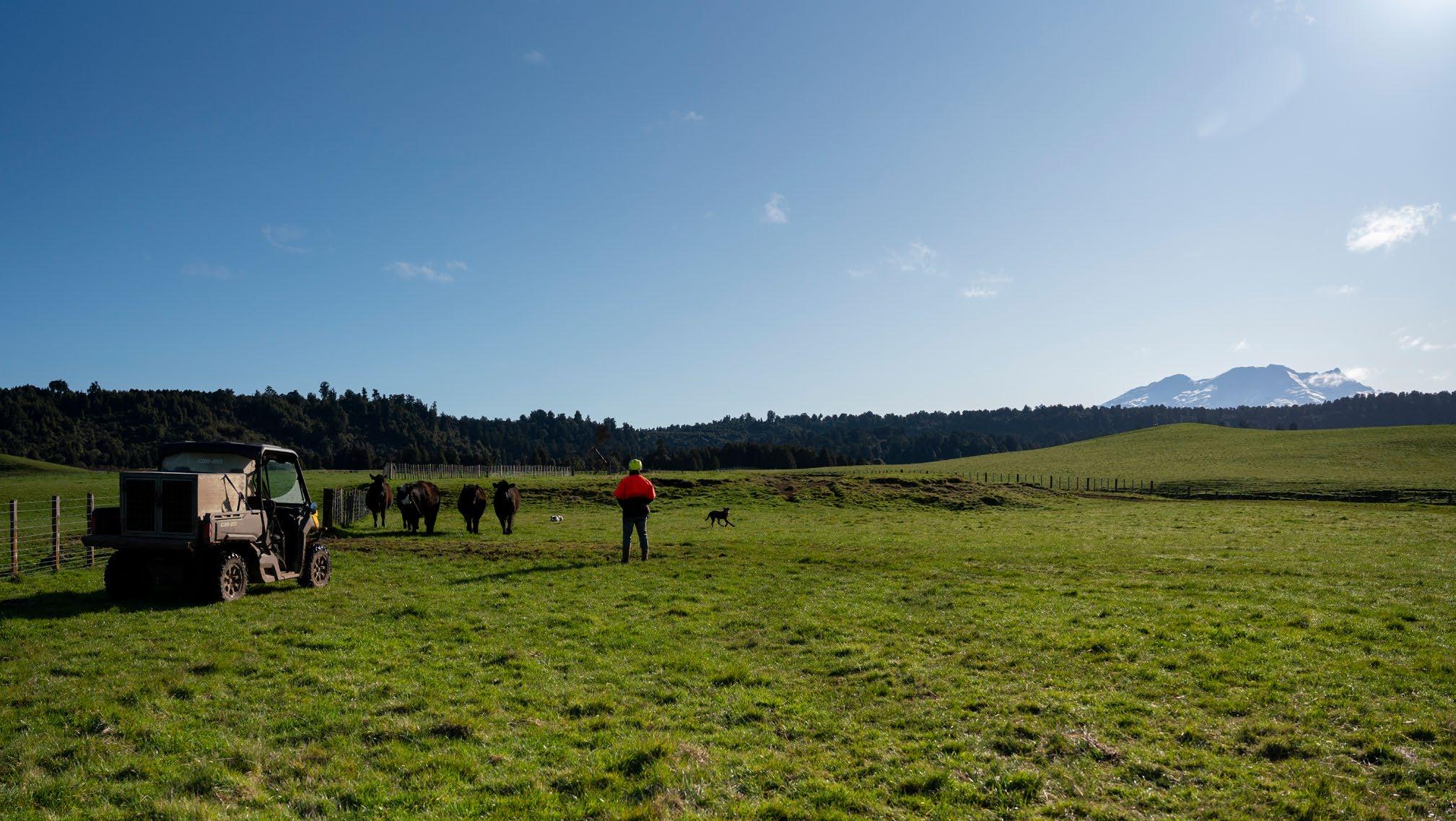
away,” says Jordan. “The animals were less stressed and grew so much faster, reaching market weights more quickly so we could get them off the farm again in less time. This also meant there was less pressure on the whenua, and the paddocks recovered more quickly.

“While production is important, of course, how we reach our targets is just as much a consideration, if not more. The welfare of our animals, and the need to care for our land so it remains healthy for the future, is key.”
While Simon and Jordan oversee the day-to-day running of the stations, farm manager Dean Francois is in regular contact, keeping his team informed about what is happening on other Ātihau farms and future plans.
“He trusts us to get on with things for the most part,” says Simon. “But we are on the phone a lot and he
comes down to get stuck in when we are drafting cattle or bringing a flock into the yards for some reason.
“The management of the farm is very much a two-way thing; we are on the same wavelength when it comes to the bigger picture. It’s great because it’s very much a team approach and you feel like you are contributing to more than just the daily mahi, that you are having a say in the decision-making process.”
Dean says his team does the hard yards and the quality of their work shows the effort and thought they put into it.
“They really respect the fact that the whenua belongs to a lot of people and that the business they are part of is a family organisation,” he says.
“When you visit these farms, you can see how much care is being put into them and the sense of pride and connection Simon and Jordan have with them.”
" The welfare of our animals, and the need to care for our land so it remains healthy for the future, is key."
Jordan BarnsPrevious page and right: Simon Lee, stock manager at Tohunga Station.
Above and far right: Jordan Barns, stock manager at Ohotu Station.
For Jordan, who has been at Ohotu for three years, the connection is one of blood. His father Peter Barns, and his grandfather Seth Barns before him, are Ātihau shareholders.
“I’ve spent all my life in Waiouru as my family is from this area, so it makes me very happy to be working on this particular farm,” he says. “It has been great to learn more about the history of the Incorporation and of the area too. It’s really helped to strengthen that connection with the land.

“My Dad was very pleased when I started this role. While he always sort of knew what was going
on at Ātihau, his interest in the organisation has grown a lot and he’s definitely more connected to things now.
“I am enjoying seeing the progress and improvements we are making each year, and I’d like to step up into a farm management role one day. It would be great if I can do that with Ātihau.”

Simon hails from South Taranaki and spent much of his career in the King Country before coming to Tohunga four years ago.
“It did take some time to really take on board the cultural importance of
what I was doing each day, and the huge connection the shareholders have with the farm, but Ātihau has helped me to understand the bigger picture and learn more about the history of the area,” he says.
“Once you get that, you really feel like you are working together with a whole heap of people toward this common goal or aspiration. It’s nice knowing the mahi I do each day is not only important to Dean, and the farm, but to this whole extended whānau. It’s a good feeling to have.”

Record dairy prices, a new milking shed and the development of top-quality beef are all positives in the progress of Te Hou farm, a joint venture between ĀtihauWhanganui Incorporation and Ngā Wairiki and Ngāti Apa.
Originally a three-way partnership between the Incorporation, Ngā Wairiki and Ngāti Apa, and brothers Hew and Roger Dalrymple, who own the neighbouring Waitatapia Station, in 2020 the iwi bought out the Dalrymples to take a two-thirds shareholding.
“The Dalrymples have played a big hand in the development of Te Hou,” says Pahia Turia, chair of Ngā Wairiki Ngāti Apa.
“We weren’t expecting them to exit quite so early, but we took the opportunity to buy their shareholding.
“And we are extremely grateful to Ātihau for their farming expertise.
“The operation was too big for us to handle as a single entity, so the partnership with Ātihau has been invaluable – they’ve been in the game a lot longer than we have.
“And, of course, it was important for us to partner with an organisation that is based on the same values.”
He says the business is performing well.
“We have had a record high dairy pay-out, and we are building a new automated dairy shed, which will be ready next year. The one we have is 25 years old.”
By June 2023, Te Hou aims to be producing 540 kilograms of milksolids per cow from a herd of 1300 on the 400ha dairy farm.
“And we are transitioning from supplying Open Country to Fonterra. It’s time for a change and we like the model of a co-operative that Fonterra offers.”
Te Hou, which is located 15km east of Bulls at Parewanui, has also embarked on a breeding programme with Wagyu cattle to produce highvalue beef on the 800-hectare dry stock farm.
Blueberries have also been introduced as a trial crop, grown in tunnels on a two-hectare plot.
“We are coming to year three of the trials, so this will be our first real production crop and we will have a look at how that progresses,” says Pahia.
“Like anything new, you have your challenges so, at this point, we are not making a commitment to longterm blueberry production.”
He said the focus would be on the core business and maximising the existing areas of operation.
“That said, the farm has lots of potential.”
A major fencing and planting
scheme shows the commitment to reducing the impacts on the environment. The past year has seen seven hectares of riparian planting to protect waterways and an extra 6km of fencing.
“We want Te Hou to lead the way with its environmental focus and be an example to others,” says Pahia.
Jarred Clode is the Operations Manager at Te Hou, having started there in 2017 as a unit manager on the dairy farm.
One of a 10-man team all provided with on-site housing, he now has oversight of the whole 1225ha operation.
“It’s a really good team here and we have been busy fencing and contouring a sand hill to bring another 30ha into production,” says Jarred.
“We have boosted maize production to a million tonnes for the dairy herd, so we don’t have to buy in expensive feed.
“This year we suffered a bit due to the dry summer, but generally the weather does not affect us too much. We have very good soil types and a good climate and are usually insulated from extremes of weather. “The coming year is looking good.”
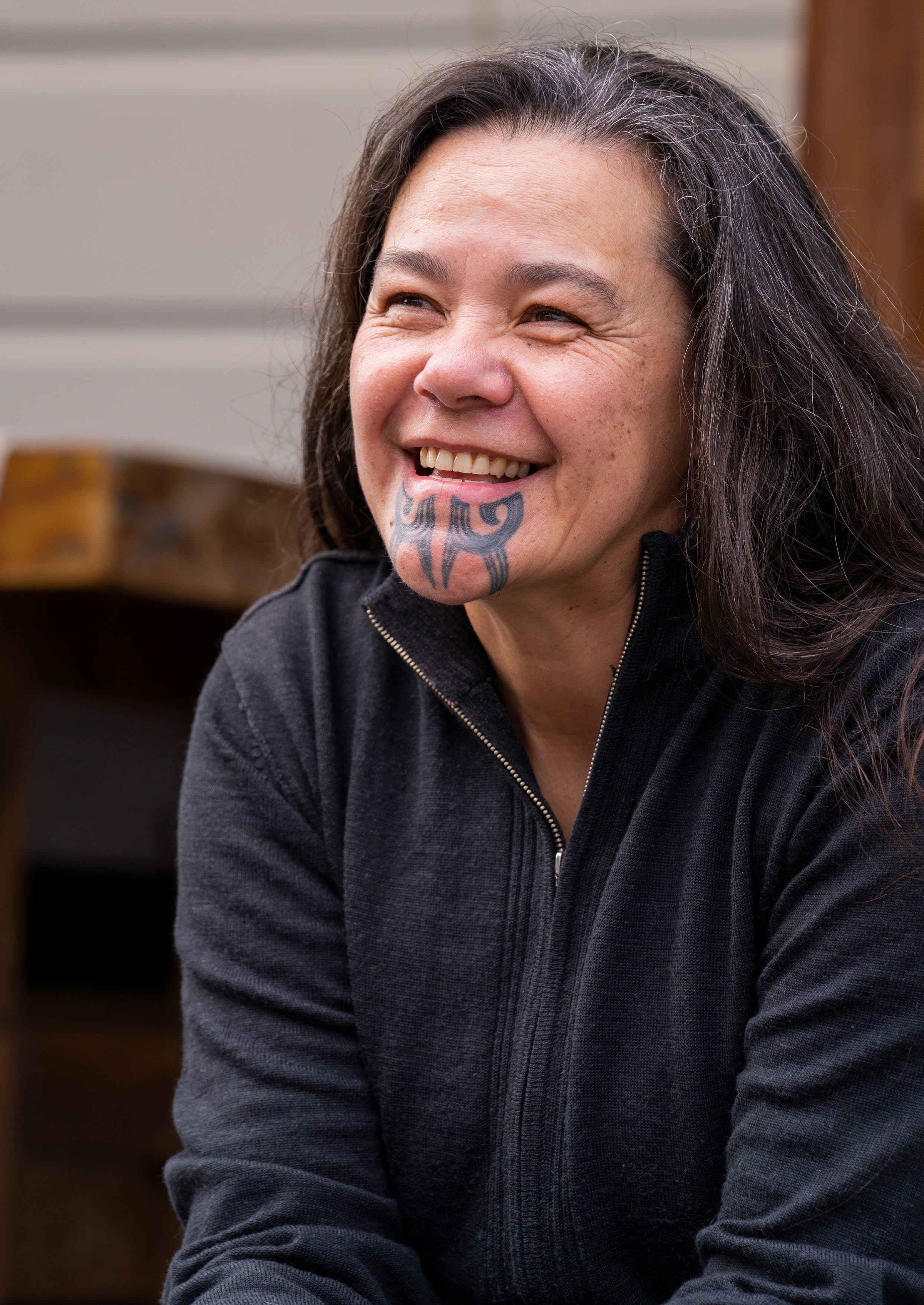
Māori visual artist Raukura NAANI WAITAI is submerged in water
“For the last two years I have been looking into the water diversions up the mountain –the water that’s taken from Te Waiū-o-Te-Ika, which is the Whangaehu catchment, and the Whanganui catchment,” Raukura Naani Waitai says.
The water is taken to make hydroelectric power.
“I considered what was happening there and I considered what our people said in their presentations to the Environment Court. I let that sit for a while and I produced my response to that… and that’s what those works are heading towards representing.”
During this Zoom interview, Naani’s real-life backdrop is of large acrylic paintings, not yet finished, leaning on her bedroom wall. She has a small art room outside, but it’s not big enough.
“In the meantime, I make do with our deck, and everything ends up in my bedroom so that I can really have a good look and see if I’m happy with it.”
One of her goals is to be a successful wahine Māori contemporary artist who makes beautiful works she can live off, comfortably, with enough to build herself an art studio in her hometown of Whanganui.
In November, her in-progress paintings will be part of a joint exhibition at Te Manawa Gallery in Palmerston North, where Naani is studying through Massey University’s College of Creative Arts, Toioho ki Āpiti.

This year, Naani received a grant from Te Āti Hau Trust to support her master’s degree. “It takes the pressure off… and helped with art resources. It’s so nice to know that our people have helped me on this journey.” Naani is an
Art flows through Naani’s whakapapa, mainly on her father’s side. Naani was born in Whanganui and spent her first few years at Rātana Pā. Then the whānau moved to Lower Hutt where her father, Rana Waitai, worked as a policeman, before becoming a lawyer and politician.
When she was a teenager, Naani returned to Whanganui and her ancestral roots. She and her husband Turama Hawira have eleven children and have almost lost count of the number of mokopuna.
From her mother, Te Aroha Anne Waitai, Naani’s iwi are Ngaa Rauru Kiitahi, Whanganui, Ngāti Ruanui, Ngā Wairiki and from her father she is Ngāti Kahungunu, Rangitāne, Ngāti Ruapani, Tūhoe and Te Iwi Mōrehu, her connection to Rātana Pā.
From a young child, Naani always liked to create things but says there were also strong artistic influences.
From a young child, Naani always liked to create things but says there were also strong artistic influences. “My dad, one of his pastimes is to recreate the oil paintings of Goldie,” she says. “When I took art at high school, one of the first artist’s works I was exposed to was a first cousin to my father; his name is Brent Wong.”
He is a surrealist painter known for his big landscape works, often featuring cumulus clouds and ethereal shapes. “It was those big landscapes that he used that have influenced some of my work,” the 54-year-old says.

When Te Rangi Koroingo Waitai, Naani’s grandfather on her dad’s side, lived at Rātana Pā, he painted flags depicting the history of Te Māramatanga, subjects important to the Rātana movement.
“Those records, I call them flags, have quite a formal arrangement,” she says. “I can see that formal arrangement has influenced my direction, although now I’m trying to become more fluid, hence water. I can still see influences of Uncle Brent, because I start with a landscape, although the landscape here is a water landscape.”
She then creates a narrative within that pictorial environment.
Naani also carries a design of the past. At age 36, she chose to receive a moko kauae, reclaiming the design from her father’s great-grandmother, Nanny Keita Whakaipo, of Ngāti Ruapani/Tūhoe. “She was taken away from her homelands and she never went back, and so our family has not had a physical connection to her. That’s why I wanted her design on me as a walking, living memory of our Nanny Keita Whakaipo and our connection with Ruapani and Tūhoe.”


In July, Naani had a solo homecoming exhibition called Reporting Back 2022, which showcased 10 acrylic-on-board works from Year 4 of her Bachelor of Māori Visual Art and Year 1 of her Master’s in Māori Visual Arts. It was held at the Whanganui Community Arts Centre.


Naani’s works were based on Whanganui and Ngāti Rangi kaupapa. “Because they were formed by these iwi kaupapa, my intention was always to bring them home,” she says.
In some of the works, she has used “te one tapu” earth pigments mixed into a clear medium.
She gathered these pigments from the desert up by the base of
Ruapehu, where the headwaters of the Whangaehu are diverted.
“As part of my practice I will visit those waterways, do karakia and do the appropriate tikanga in those areas.” That’s so the people and the elements know what she’s doing.
She paints with the pigments. “I use them as a base so that the mouri of the area is imbued into the works.”
The pigments will also be used in the November show.
“For myself it was really about finding a way to communicate the way our people feel about the diversions for hydroelectricity. Huge amounts of water are continuously taken from the Wāhianoa aqueduct for the Tongariro power scheme,” she says.
“It’s like a taniwha that swallows the mouri of the water,” Naani says. “I have a huge interest in water and what our people have said. I let things percolate or sit within me until a response comes. My work this year has definitely been a response to what I’ve digested.”
Or been submerged in.
"As part of my practice I will visit those waterways, do karakia and do the appropriate tikanga in those areas.”
When Leroy Hiroti competed at the world waka ama championships in England during August, he took to the water with everyone who supported him.

“I got my paddle, my hoe, and wrote down all the people who helped me,” says Leroy Hiroti. That included Te Āti Hau Trust, other grant makers, iwi and Leroy’s whānau and friends.
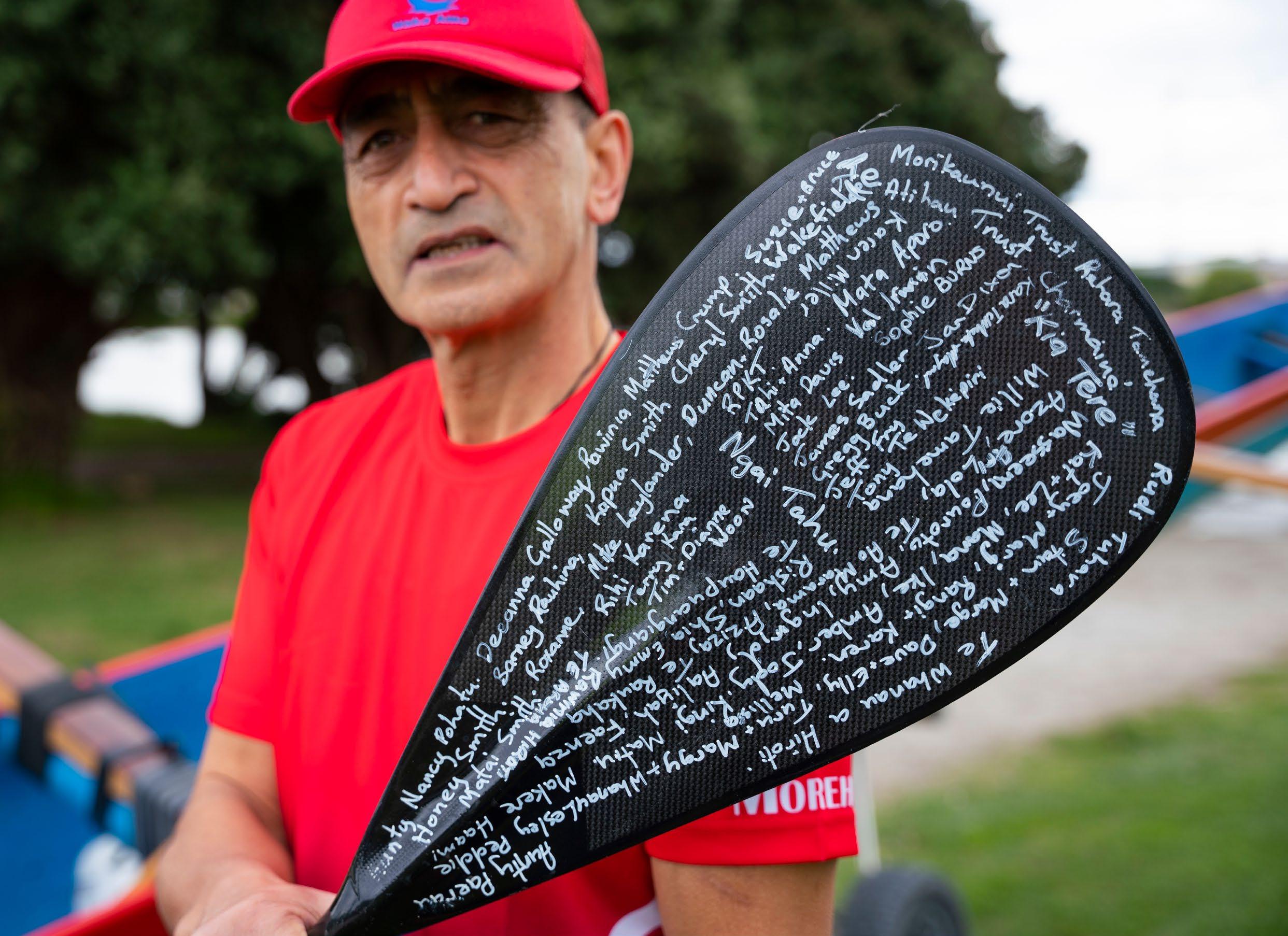
Leroy was a member of Rātana Pā Kaihoe Trust Golden Masters Men’s Tipi Haere, which competed in the 19th International Va’a Federation World Elite and Club Sprint Championships at Dorney Lake in Windsor, near London, from August 8-16 this year. While the sport is called waka ama in New Zealand, in Europe it’s called outrigger and in some of the Pacific Islands it’s called va’a, hence the name of the championships.
In the team along with Leroy were fellow recipients of Te Āti Hau Trust Sport Art Culture Grants,
Tahi Nepia and Anthony (Tony) Te Wekepiri. The rest of the team were Jeff Fry, James Sadler, Greg Buck and reserve, Val Irwin. They competed in the V6 500 and V6 1000, and joined with another team to compete in the V12 1000.
“We didn’t win any medals; the highest rating we got was fifth in the final for the 12-man,” Leroy says.
But two other grant recipients did bring home medals. Troy and Hunter Hewson (Ngāti Porou, Ngāti Kahungunu ki Te Wairoa) represented Horouta Waka Hoe Ama Club from their hometown of Gisborne. The pair attend Manukura School in Palmerston North.
Hunter, 17, competed in all elite categories as well as the J19 categories, bagging four gold medals
“I got my paddle, my hoe, and wrote down all the people who helped me,”
Leroy HirotiAbove: Leroy Hiroti with the paddle inscribed with the names of all those who supported him to the world waka ama championships in England.
Opposite page, top: Leroy Hiroti and Tahi Nepia prepare to launch their waka at the Pūtiki boat ramp in Whanganui.
Opposite page, bottom: Tahi Nepia in action on the Whanganui awa.
and one bronze. Troy, 15, competed in all J16 categories, winning a gold medal.
Hunter says to get to the Worlds, there was a lot of hard work behind the scenes fundraising with his whānau, and hard toil on the water.
“All the hours, all the days, all the weeks we’ve been training in the cold here in Palmerston North, all for those two minutes of hard work. It pays off and it feels good to be on top of the world,” he told Te Ao Māori News.
On the flipside of the globe, the world champs at Dorney Lake were held in hot summer conditions – the average daytime temperature was +28°C and the hottest day was about +31°C on the afternoon of August 11. The purpose-built lake is privately owned by prestigious
boys’ school Eton College and was used for the Olympic rowing events in 2012.
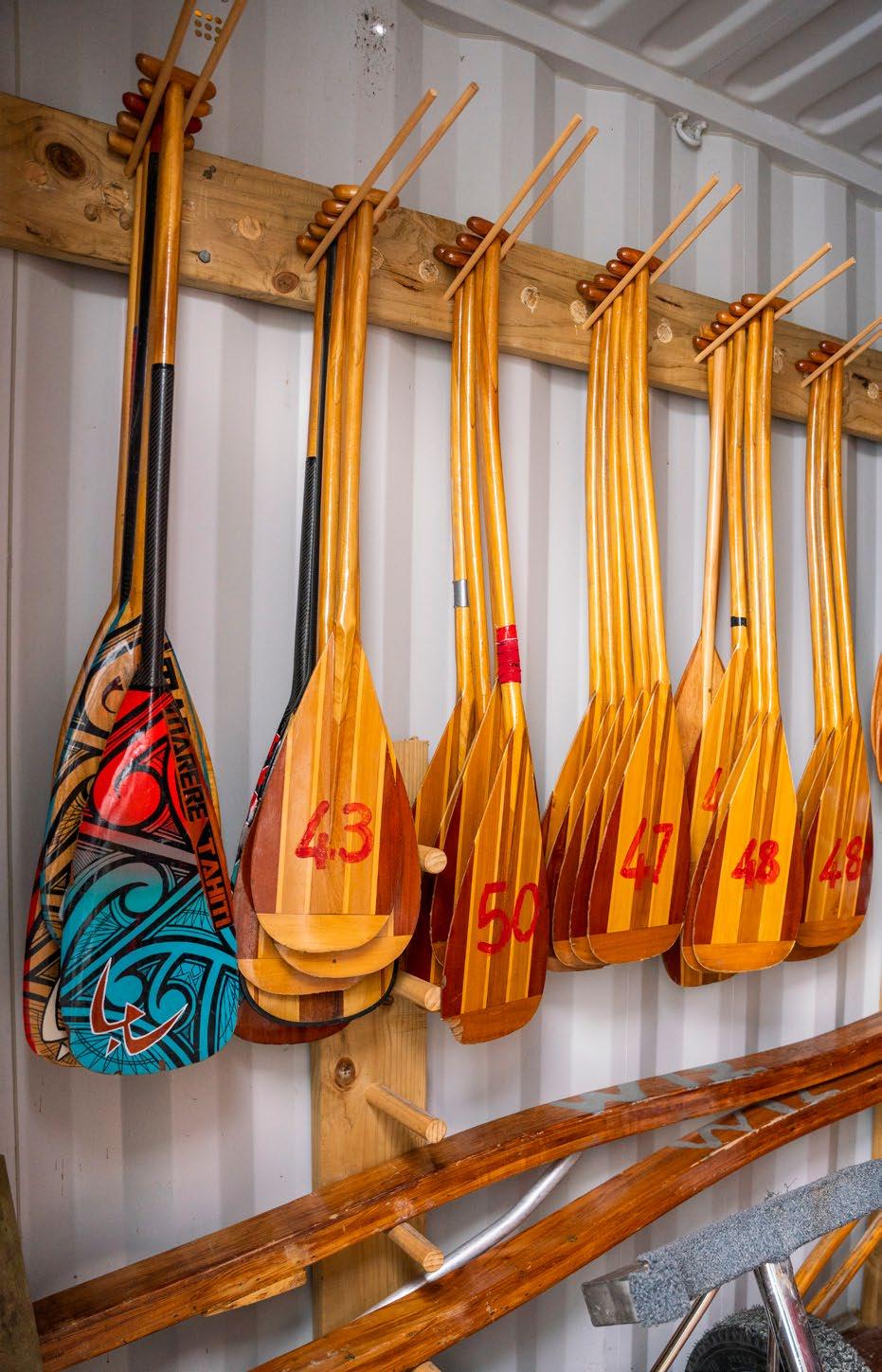
Meanwhile, Leroy (Ngā Wairiki, Ngā Paerangi, Ngāti Apa, Te Ātihaunui-a-Pāpārangi, Ngāi Tumapuhia-a-rangi, Ngāi Tahu) says he was originally reluctant to attend the world champs because he was so busy and knew there would be a lot of fundraising involved. But his mate Tahi was insistent, so Leroy said yes and embraced a range of ways to raise funds.
Then he found out that as a shareholder of Ātihau-Whanganui Incorporation (Ātihau), he could apply for a Te Āti Hau Trust grant, which is focused on “enabling our people to reach their potential”.
He applied, as did Tahi and Tony, and all received Sport Art Culture Grants.
“That was awesome. I didn’t expect to get anything – I was just so blown away by that,” Leroy says.
Leroy, who is a kitchen assistant at Whanganui Collegiate School, says his last journey out of Aotearoa was to Fiji in 1973.
“I just want to make a big shout out to everyone who helped me raise that money… and to everyone I paddled with as well, because they’ve all helped me on this journey. “I’m definitely pleased I went. It was just amazing. I just learnt so much from that trip.”
Leroy, who took up paddling two-and-a-half years ago, dreams of waka ama being available to everyone, not just those who compete in the sport. He says there are many different funds and grants available from iwi, trusts and sports >>
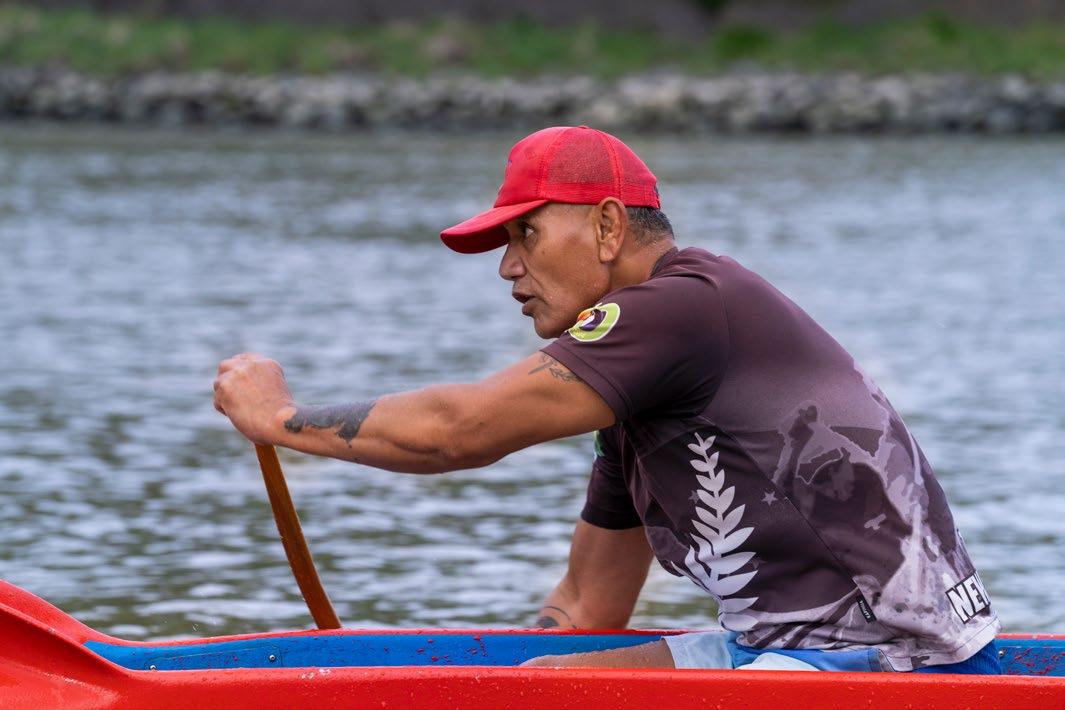

organisations, which could be used to start a waka ama club for health and mental wellbeing.


“Many people are too shy to have a go at it because they feel they are not fit enough or confident enough, and I don’t blame them because waka ama teams are quite competitive,” he says.
“If there was a place where people could actually go out on the water, especially on our awa. It’s such a beautiful river – I can see it helping lots of people.”
Leroy says paddling on the water always feels spiritual to him.
“I like the way Tahi said to me, ‘When we’re paddling on the water, we’re actually caressing our ancestors.’”
“I like the way Tahi said to me, ‘When we’re paddling on the water, we’re actually caressing our ancestors.’”
Leroy Hiroti
 Opposite: Leroy Hiroti, Tahi Nepia and Anthony (Tony) Te Wekepiri ready for training at the Pūtiki boat ramp in Whanganui.
Opposite: Leroy Hiroti, Tahi Nepia and Anthony (Tony) Te Wekepiri ready for training at the Pūtiki boat ramp in Whanganui.